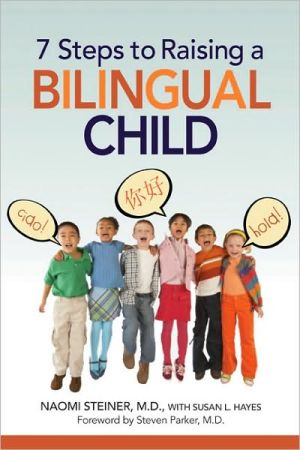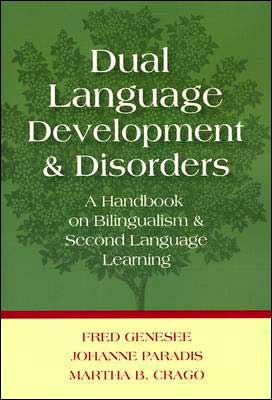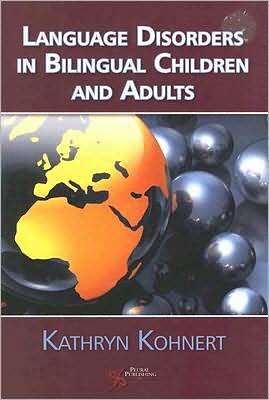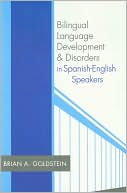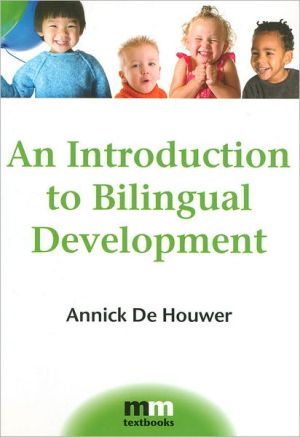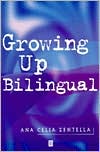7 Steps to Raising a Bilingual Child
The best time to learn a second language is as a child. During childhood, the brain is more receptive to language learning than at any other time in life. Aware that a second language can enrich their child’s understanding of other cultures and bring future job opportunities in a world drawn ever closer by globalization, many parents today are motivated to raise their children bilingual.\ This book helps parents in both monolingual and multilingual families determine and achieve their...
Search in google:
“Kids think it’s cool to be smart. And what says smart more than speaking two languages? 7 Steps to Raising a Bilingual Child shows us that nearly every child can learn a second language, and this excellent resource will inspire and guide you to help your kids do just that.” — Melina Gerosa Bellows, Editor in Chief, National Geographic Kids and author of The Fun Book for Moms: 102 Ways to Celebrate Family No matter what age your child is or whether you speak one or more languages, you can raise your child to be bilingual! 7 Steps to Raising a Bilingual Child makes it easy for all parents to embark on this remarkable and rewarding journey. The book’s step-by-step approach, which can be adapted by all families, will help you determine and achieve your bilingual goals for your child, whether those goals are understanding a second language, the ability to speak another language, or even reading and/or writing in two languages. 7 Steps to Raising a Bilingual Child explodes common myths about bilingualism, explains how the brain learns more than one language, answers frequently asked questions, and reveals an array of bilingual resources available to you and your family regardless of where you live. The book presents common hurdles and provides useful tips for conquering them. It also helps you navigate foreign-language learning opportunities in the public school system and offers concrete advice for handling special situations that can affect bilingual academic progress. Packed with insightful anecdotes and powerful strategies, this one-of-a-kind guidebook will enable you to provide your child with a uniquely valuable and enriching experience. Naomi Steiner, M.D., is a developmental-behavioral pediatrician at Tufts Medical Center Boston. Dr. Steiner is an expert in the methods that are used to teach children more than one language, and she works closely with many bilingual and multilingual families. She is raising her own two children multilingual and lives in Boston. Susan L. Hayes is a writer and editor whose work has appeared in Parent & Child, Parenting, Woman’s Day, and other publications. She lives in Brooklyn. Phyllis Goodman - Library Journal Pediatrician Steiner (Tufts Medical Ctr.) has created a step-by-step plan to help parents who want their children to learn a second language. The book is geared to bilingual parents who no longer live in their birth country but want their children to learn their native language-though monolingual parents who want their children to learn a second language will also benefit from the information presented here. Steiner starts off by exploring common myths about bilingual education and how the brain processes learning a second language. She then proceeds in an organized fashion to show parents how to establish a language action plan. Using charts and work sheets throughout, she explains how to set goals, decide on a language, eliminate obstacles, find resources, and finally implement the plan. Real-life situations are addressed, and Q&A sections are scattered throughout. Online and community resources are listed at the end to supplement the language plan. Recommended for large public libraries and libraries serving diverse cultures.
\ INTRODUCTION\ \ People are often amazed when my children switch from speaking English with them to talking to my husband in Italian, and then go off to converse in German with their grandmother. “How can your kids be so comfortable speaking more than one language?” they ask.\ “They live in an environment where more than one language is spoken,” I answer. “So that is what they’ve learned to do.” This is true enough—but it’s only the tip of the iceberg.\ The rest of the iceberg is vast indeed. Deciding to raise children who speak more than one language is like many other parenting decisions: You start off by gathering information from friends, experts, authors of books and magazine articles, and the Internet. Then, you make the best decision for your family and develop a plan to carry it out.\ I first began considering the possibility of raising my children to be bilingual when I was pregnant with my oldest child. Although I was born in England, I grew up speaking four languages. My Swiss husband spoke five. How many languages, I wondered, could our baby learn?\ As a developmental and behavioral pediatrician now living in the United States, I was initially confident that I could find the information I needed to make educated choices about raising my children to be bilingual, or even multilingual. After all, in the busy Boston hospital where I practice medicine, I have easy access to speech and language therapists, education specialists, child psychologists, and the most current research studies available.\ However, I soon realized that there were enormously conflicting opinions. While some experts were certainly encouraging about raising bilingual children, others cautioned me “not to confuse my child.” In other words, I received the same mixed messages about bilingualism that my patients did!\ This was more than a little surprising to me, since nearly 20 percent of the children in the United States are currently being brought up to be bilingual, and most parents—like me—have a gut feeling that teaching their child a second language is the right thing to do. As a result, I decided to explore the topic of raising bilingual children more fully. I have spent the past decade conducting my own research on the subject, as my children are growing and are learning multiple languages and as I have continued working with many families who are on the same journey.\ In this book, I will take you on a journey of discovery, and I’d like to begin by telling a little bit about my own family’s journey. Be assured that my husband and I initially experienced some of the same trepidations that you might be feeling right now, not the least of which was “can we really pull this off?” But we cast away our fears and decided that my husband would speak to our children in Italian and I would speak to them in English. (This is called the One-Parent- One-Language method, which is explained in detail in Step 3.) Even so, my husband was unsure that he could speak to our kids only in Italian. Perhaps like you, he was not surrounded by family members who spoke the language, and he was not even speaking it himself on a daily basis. But I hope you’ll take heart from our experience. We were both surprised how fast he got into the groove, and how much he enjoyed it. Our children are now 11 and 9, and Italian is the only language that they speak with their dad. What’s been really wonderful for me to see is that by sharing a language not spoken by everyone else around them, they’ve developed a bond that goes so much deeper than simply using words to communicate. When our family returns to the village where my husband grew up, it’s as though the children are proudly going back to where they come from too.\ I speak only English to the children, and continued to do so even when we lived for a few years in a non-English speaking country. My husband and I speak French to each other, and it has been fascinating to observe the effect this has on our children. One evening when my son was only a toddler, my husband said to me in French, “He looks tired. I think he needs to go to bed,” to which our son immediately answered back in English, “I’m not tired!” No secret language for us, I’m afraid! Both our children understand and can speak some elementary French sentences. (I will speak more about this phenomenon of passively learning a language in Steps 1 and 2.)\ One thing I learned early on from my research and personal experience, however, is that people feel very strongly about bilingualism, no matter what their own background. The languages we speak have a huge impact on our personal and political identities. Multiple myths—which I discuss in the first chapter—about bilingualism continue to propagate various concerns regarding the adverse effects of raising children to speak more than one language. Even the pediatric residents I teach at the medical center where I work are surprised to hear that bilingualism is not only natural—the majority of people around the world are bilingual—but that it is a fabulous stimulation for a child’s developing brain.\ Here’s another thing that might surprise you: Parents do not have to be bilingual themselves to raise a bilingual child. I’d like to take a moment here to specifically address monolingual parents. If you are monolingual, you can still raise your children to be bilingual! The step-by-step approach described in this book will work for you, too.\ Fortunately, new advances in psycholinguistics and brain research have made it easier to bust these and other negative myths about bilingualism. We can now safely say that there is no scientific evidence to support the idea that giving up one language necessarily promotes the development of another. A child who stops speaking Spanish or Russian, for instance, will not become a better English speaker simply because he focuses his attention on one language.\ In this book I will share with you the information I began gathering from professionals and research studies when I was an expectant mother and that I continue to gather today, many years later. Out of this information and my own experience, I have developed a step-by-step approach that will take you from thinking about raising a bilingual child to developing and carrying out a plan for making it happen to overcoming the challenges that can accompany raising a bilingual child. There are a total of seven steps, and each step is one chapter in this book.\ In the same way that building a house atop a foundation makes it stronger, having a foundation for raising your child bilingual can make the process easier and go more smoothly. That foundation is understanding bilingualism. I have seen many dedicated parents fail in their effort simply because they did not know the basic facts about bilingualism. Moreover, having this understanding will not only help you teach your child to speak more than one language, it will help you weather the challenges that are inevitably part of the journey and stand firm in your conviction that this was the right decision for you and your child. I help you build the foundation for raising your child bilingual in the first chapter of this book.\ The second logical step is to define your bilingual goals. Each parent can have different expectations of what their goals are for their children. Even the definition of bilingualism isn’t as obvious as you might think. Just the other day, a pediatrician I work with was surprised to hear that she was bilingual. She can speak some Korean and reads the Korean alphabet, but has difficulty making out the words, so she has never defined herself as “bilingual.”\ Once you define your bilingual goals, the next two steps are to become comfortable in your role as a bilingual coach and to create a workable Bilingual Action Plan that will allow you to turn your goals into reality. Steps 3 and 4 are critical because children don’t just automatically pick up languages. Consistent language input is key, and as you’ll see, explicitly defined roles and activities are the key to consistency. Worksheets at the end of Step 4 will help you identify the different bilingual enrichment areas that you want to draw from and create your Bilingual Action Plan. I’ll offer examples from other bilingual families that will give you new ideas for supporting a rich bilingual family environment. (You will also find a handy Resource List at the back of the book that you can easily refer to again and again.)\ Life, of course, doesn’t always go along as expected. In Step 5, I’ll present the most predictable hurdles bilingual families face as their children grow and provide strategies for conquering them. What do you do, for instance, when your kindergartner, who has been learning Spanish and English since birth, suddenly insists on speaking only English and pretends not to understand when spoken to in Spanish?\ In Step 6, I will explain learning to read and write in a second language. In this “hands-on” chapter, I’ll offer concrete examples and activities, illustrating, for example, how to read to your child in a second language.\ Finally, there is the academic side of learning languages. In the seventh and final step, I offer a window into the academic lives of bilingual children from preschool through high school. Depending on their personalities, language abilities, and environments, bilingual children take different approaches to school. Some children leap into a bilingual preschool as if it were just another adventure, whereas others initially withdraw and refuse to speak at all in another language. I have observed children learning to read in two different languages without difficulty, while for others, battling two different phonetic systems can simply be too much. If your child struggles with bilingualism in preschool or school, I’ll show you how to keep your child’s bilingual abilities alive, so that she still feels comfortable with her second or third language.\ But as I emphasize at the end of Step 7, the key to raising a bilingual child is to be flexible even when special circumstances crop up to revise your Action Plan, so that your child never has to give up her second language. Along the road to raising a bilingual child, you will—like most parents—sometimes suffer doubts and setbacks. Raj, a freshly graduated college student, recently told me that he was quite fluent in Hindi until high school. Then, as part of his teenage rebellion, he stopped speaking Hindi entirely. Now, nearly 10 years later, he has lost most of his heritage language. Raj says he can now speak Hindi only haltingly and truly regrets that he’s not as proficient in the language as he was before. Unfortunately, that is the hard reality of how the brain works: If a language is not used, the brain loses the ability to speak it on command and moves on to perfecting other skills, such as writing essays or learning algebra. But the good news is if a person has at least some active understanding or speaking skills in a language, as Raj does, he can use them as a trampoline to regain his skills in that language fairly rapidly, once he puts in the time and effort.\ But the truth is, if Raj’s family had reassessed its goals and continued to support his bilingual environment even in the face of his rebellion, he might not have had such a setback at all. The surest way to successfully raise bilingual children is to remain flexible enough to find new ways to support and enrich your family’s bilingual environment as your children’s needs change. This book will help you both remain true to your bilingual goals and achieve that needed flexibility.\ One final note: In my work as a developmental pediatrician, I have yet to meet a parent who regretted raising her child to be bilingual. However, I have heard many, many stories of regret from parents who did not make this choice. My hope in writing this concise, pragmatic, step-by-step book is that you will use it as a guide for offering your children the gift of speaking more than one language.\ \
CONTENTS Foreword IntroductionStep 1: Building the Foundation for Your Child’s Bilingualism What Does It Mean to Be a Bilingual Family What Does It Mean to Be Bilingual? 7 Common Myths about Bilingualism The Bilingual AdvantageStep 2: Making It Happen: Defining Your Goals Decide Which Languages Are Important to You and Why Identify Your Motivations for—and Your Reservations about—Bilingualism Worksheet 1 Language Questionnaire Choose Which Language(s) You and Your Partner Are Going to Speak to Your Child Set a Start Date Determine How Proficient You Hope Your Child Will Be in a Second Language Do a Reality Check. Are Your Proficiency Goals Realistic for Your Family? Take into Account That One Language Will Be Dominant Worksheet 2 My Bilingual Goals and ChoicesStep 3: Becoming a Bilingual Coach Part One: Taking Charge Part Two: Who Speaks Which Language When?Step 4: Creating Your Bilingual Action Plan Part One: Maximizing Language Input at Home Part Two: Making The Most of Community and Family Resources Part Three: FindingSchool Support Part Four: How Three Families Are Raising Bilingual Children Part Five: Create Your Own Bilingual Action Plan Worksheet 3 What Are the Key Components to My Bilingual Action Plan? Worksheet 4 Our Family’s Weekly Bilingual ScheduleStep 5: Leaping over Predictable Obstacles Predictable Obstacle 1: I’m Not Sure That I’m Speaking to My Child in a Way That Will Help Him Become Bilingual Predictable Obstacle 2: My Child Does Not Want to Speak My Language Anymore—She Only Wants to Speak English Predictable Obstacle 3: My Child Keeps Mixing Languages Predictable Obstacle 4: I’m Self-Conscious about Speaking My Language to My Child in Public Predictable Obstacle 5: Because I’m the One Who Speaks a Second Language, I Feel Like I’m the One Doing All the Work to Raise Our Child Bilingual Predictable Obstacle 6: My Work Schedule Has Become Really Hectic, and There’s Little Time for My Child’s BilingualismStep 6: The “Two Rs”: Reading and Writing in Two Languages Reading in a Second Language The Write StuffStep 7: Adapting to School: The Bilingual Child Goes to School Part One: Public Bilingual Education Programs: Where We’ve Been, Where We’re at, and Where We’re Going Part Two: Results May Vary: How to Handle Special Situations That Can Affect Your Child’s Bilingual Academic ProgressConclusion Bilingual Resource List
\ From the Publisher"Recommended for large public libraries and libraries serving diverse cultures.” --Library Journal\ \ \ \ \ \ Library JournalPediatrician Steiner (Tufts Medical Ctr.) has created a step-by-step plan to help parents who want their children to learn a second language. The book is geared to bilingual parents who no longer live in their birth country but want their children to learn their native language-though monolingual parents who want their children to learn a second language will also benefit from the information presented here. Steiner starts off by exploring common myths about bilingual education and how the brain processes learning a second language. She then proceeds in an organized fashion to show parents how to establish a language action plan. Using charts and work sheets throughout, she explains how to set goals, decide on a language, eliminate obstacles, find resources, and finally implement the plan. Real-life situations are addressed, and Q&A sections are scattered throughout. Online and community resources are listed at the end to supplement the language plan. Recommended for large public libraries and libraries serving diverse cultures.\ —Phyllis Goodman\ \ \
